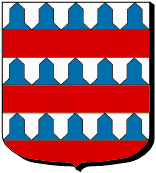Coucy-le-Château-Auffrique: Difference between revisions
Jump to navigation
Jump to search
Knorrepoes (talk | contribs) m (Text replacement - "{{France}}'''" to "{{France}} '''") |
Knorrepoes (talk | contribs) m (Text replacement - "====Origin/meaning====" to "===Origin/meaning===") |
||
| Line 10: | Line 10: | ||
Fascé de vair et de gueules. | Fascé de vair et de gueules. | ||
===Origin/meaning=== | |||
There is a story on the background of the arms, dating back to the 11<sup>th</sup> century : Enguerrand I de Coucy participated in France's First Crusade (1096). Was awarded the arms as result of a battle wherein he and his men were attacked at night; he tore his robe into six pieces, and gave each of his men a piece. They successfully fended off the attack. Hence the six seemingly torn bands on the shield. | There is a story on the background of the arms, dating back to the 11<sup>th</sup> century : Enguerrand I de Coucy participated in France's First Crusade (1096). Was awarded the arms as result of a battle wherein he and his men were attacked at night; he tore his robe into six pieces, and gave each of his men a piece. They successfully fended off the attack. Hence the six seemingly torn bands on the shield. | ||
Revision as of 19:04, 22 June 2017
COUCY-LE-CHÂTEAU-AUFFRIQUE
Département : Aisne
Official blason
Fascé de vair et de gueules.
Origin/meaning
There is a story on the background of the arms, dating back to the 11th century : Enguerrand I de Coucy participated in France's First Crusade (1096). Was awarded the arms as result of a battle wherein he and his men were attacked at night; he tore his robe into six pieces, and gave each of his men a piece. They successfully fended off the attack. Hence the six seemingly torn bands on the shield.
As this probably pre-dates modern heraldry, the story is rather unlikely.
Contact and Support
Partners:
Your logo here ?
Contact us
© since 1995, Heraldry of the World, Ralf Hartemink 
Index of the site
Literature : Image taken from La banque du blason (with permission)










